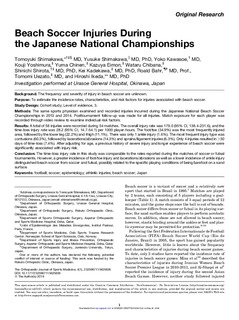| dc.contributor.author | Shimakawa, Tomoyuki | |
| dc.contributor.author | Shimakawa, Yusuke | |
| dc.contributor.author | Kawasoe, Yoko | |
| dc.contributor.author | Yoshimura, Kouji | |
| dc.contributor.author | Chinen, Yuma | |
| dc.contributor.author | Eimon, Kazuya | |
| dc.contributor.author | Chibana, Wataru | |
| dc.contributor.author | Shirota, Shinichi | |
| dc.contributor.author | Kadekawa, Kei | |
| dc.contributor.author | Bahr, Roald | |
| dc.contributor.author | Uezato, Tomomi | |
| dc.contributor.author | Ikeda, Hiroshi | |
| dc.date.accessioned | 2016-06-29T11:43:17Z | |
| dc.date.available | 2016-06-29T11:43:17Z | |
| dc.date.issued | 2016-01-26 | |
| dc.identifier.citation | The Orthopaedic Journal of Sports Medicine. 2016, 4,1 | nb_NO |
| dc.identifier.uri | http://hdl.handle.net/11250/2394684 | |
| dc.description | This article is distributed under the terms of the Creative Commons Attribution-NonCommercial-NoDerivs 3.0 License (http://www.creativecommons.org/licenses/by-nc-nd/3.0/) which permits non-commercial use, reproduction and distribution of the work as published without adaptation or alteration, without further permission provided the original work is attributed as specified on the SAGE and Open Access page (https://us.sagepub.com/en-us/nam/open-access-at-sage). | nb_NO |
| dc.description.abstract | Background: The frequency and severity of injury in beach soccer are unknown.
Purpose: To estimate the incidence rates, characteristics, and risk factors for injuries associated with beach soccer.
Study Design: Cohort study; Level of evidence, 3.
Methods: The same sports physician examined and recorded injuries incurred during the Japanese National Beach Soccer Championships in 2013 and 2014. Posttournament follow-up was made for all injuries. Match exposure for each player was recorded through video review to examine individual risk factors.
Results: A total of 58 injuries were recorded during 54 matches. The overall injury rate was 179.0 (95% CI, 138.4-231.6), and the time-loss injury rate was 28.2 (95% CI, 14.7-54.1) per 1000 player-hours. The foot/toe (34.9%) was the most frequently injured area, followed by the lower leg (22.2%) and thigh (11.1%). There was only 1 ankle injury (1.6%). The most frequent injury type was contusions (60.3%), followed by lacerations/abrasions (14.3%) and sprains/ligament injuries (6.3%). Only 4 injuries resulted in ≥30 days of time-loss (7.4%). After adjusting for age, a previous history of severe injury and longer experience of beach soccer were significantly associated with injury risk.
Conclusion: The time-loss injury rate in this study was comparable to the rates reported during the matches of soccer or futsal tournaments. However, a greater incidence of foot/toe injury and lacerations/abrasions as well as a lower incidence of ankle injury distinguished beach soccer from soccer and futsal, possibly related to the specific playing conditions of being barefoot on a sand surface. | nb_NO |
| dc.language.iso | eng | nb_NO |
| dc.publisher | Sage Publications | nb_NO |
| dc.subject | football | nb_NO |
| dc.subject | soccer | nb_NO |
| dc.subject | epidemiology | nb_NO |
| dc.subject | athletic injuries | nb_NO |
| dc.subject | beach soccer | nb_NO |
| dc.subject | Japan | nb_NO |
| dc.title | Beach soccer injuries during the Japanese National Championships | nb_NO |
| dc.type | Journal article | nb_NO |
| dc.type | Peer reviewed | nb_NO |
| dc.subject.nsi | VDP::Medical disciplines: 700 | nb_NO |
| dc.subject.nsi | VDP::Medical disciplines: 700::Sports medicine: 850 | nb_NO |
| dc.source.journal | Orthopaedic Journal of Sports Medicine (OJSM) | nb_NO |
| dc.identifier.doi | 10.1177/2325967115625636 | |
| dc.description.localcode | Seksjon for idrettsmedisinske fag / Department of Sport Medicine | nb_NO |
